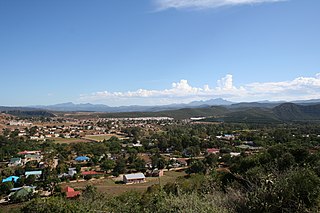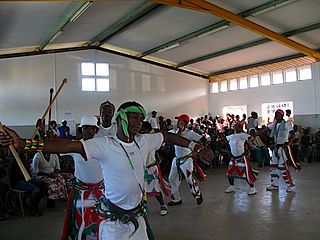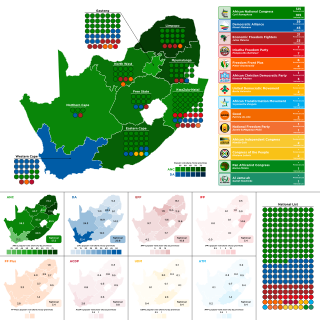
In South Africa, the terms township and location usually refer to the often underdeveloped racially segregated urban areas that, from the late 19th century until the end of apartheid, were reserved for non-whites, namely Black Africans, Coloureds and Indians. Townships were usually built on the periphery of towns and cities. The term township also has a distinct legal meaning in South Africa's system of land title, which carries no racial connotations.

Diepsloot, Afrikaans for "deep ditch", is a densely populated township in Gauteng, South Africa. It is located in the Region A of the City of Johannesburg Metropolitan Municipality. There are high levels of crimes here including illegal electricity connections and theft.
Kya Sand is an industrial suburb of Randburg, South Africa. It is located in Region A of the City of Johannesburg Metropolitan Municipality. The suburb is bordered to the east by Kya Sands Informal Settlement.

The suburbs of Johannesburg are officially demarcated areas within the City of Johannesburg Metropolitan Municipality, South Africa. As in other Commonwealth countries, the term suburb refers to a "neighbourhood", although in South Africa most "suburbs" have legally recognised borders and often separate postal codes. The municipal functions for the area, such as municipal policing and social services, are still managed by the city government.

The City of Johannesburg Metropolitan Municipality is a metropolitan municipality that manages the local governance of Johannesburg, the largest city in South Africa. It is divided into several branches and departments in order to expedite services for the city. Zulu is the most spoken home language at 23.4% followed by English at 20.1%.

Transnet SOC Ltd is a large South African rail, port and pipeline company, headquartered in the Carlton Centre in Johannesburg. It was formed as a limited company on 1 April 1990. A majority of the company's stock is owned by the Department of Public Enterprises, or DPE, of the South African government. The company was formed by restructuring into business units the operations of South African Railways and Harbours and other existing operations and products.

Crime in South Africa includes all violent and non-violent crimes that take place in the country of South Africa, or otherwise within its jurisdiction. When compared to other countries South Africa has notably high rates of violent crime and has a reputation for consistently having one of the highest murder rates in the world. The country also experiences high rates of organised crime relative to other countries.

Abahlali baseMjondolo is a socialist shack dwellers' movement in South Africa which primarily campaigns for land, housing and dignity, to democratise society from below and against xenophobia.

Kennedy Road is an informal settlement in Durban (eThekwini), in the province of KwaZulu-Natal in South Africa. Formed in the late 1970s or early 1980s, the settlement was mentioned by the African National Congress (ANC) after the end of apartheid but amenities were not improved. The site is mostly not connected to sanitation or electricity. Dissatisfaction with local councillors led to 2005 protests including a road blockade, out of which the shack dwellers movemment Abahlali baseMjondolo (AbM) formed. In 2009, an AbM meeting was attacked resulting in two deaths and a court case. More recently, the municipality has improved facilities and promised to relocate inhabitants.

The Landless People's Movement is an independent social movement in South Africa. It consisted of rural people and people living in shack settlements in cities. The Landless People's Movement boycotted parliamentary elections and had a history of conflict with the African National Congress. The Landless People's Movement was affiliated to Via Campesina internationally and its Johannesburg branches to the Poor People's Alliance in South Africa.
South Africa has been dubbed "the protest capital of the world", with one of the highest rates of public protests in the world.

Symphony Way Temporary Relocation Area in Delft, Cape Town, better known by its nickname Blikkiesdorp, is a relocation camp made-up of corrugated iron shacks. Blikkiesdorp, which is Afrikaans for "Tin Can Village", was given its name by residents because of the row-upon-row of tin-like one room structures throughout the settlement.

John Henry Steenhuisen is a South African politician who has served as the twentieth leader of the Opposition since October 2019 and has been the leader of the Democratic Alliance since November 2020, having served as the interim leader for one year from November 2019. He was chief whip of the official opposition from May 2014 until October 2019. Ideologically, Steenhuisen has been described as a classical liberal, a supporter of non-racialism and a firm believer in racial equality.
QQ Section also known as Tambo Park, was founded in 1989 and is an Informal Settlement in the Site B sub-division of Khayelitsha in South Africa.
Dunoon is a city in the Western Cape province of South Africa. The first erf for Dunoon was surveyed in 1996. As formal housing was built, shacks developed rapidly.

Mukuru is a collection of slums in the city of Nairobi. It is approximately 7 kilometres (4.3 mi) south of the central business district of Nairobi. It is one of the largest slums in Nairobi. It stretches along the Nairobi–Ngong River, situated on waste lands in the industrial area of the city between the Outering Ring Road, North Airport Road and Mombasa Road. Mukuru is among other major slums in Nairobi such: Korogocho, Kibera and Mathare.

General elections were held in South Africa on 8 May 2019 to elect a new President, National Assembly and provincial legislatures in each province. These were the sixth elections held since the end of apartheid in 1994 and determined who would become the next President of South Africa.

The Greenmarket Square refugee sit-in was a sit-in protest by a group of refugees for the purpose of getting relocated to a country outside of South Africa in response to xenophobia in the country. It lasted from 8 October 2019 when protestors first occupied the Waldorf Arcade to 2 April 2020 when the last group of protestors were evicted from the Central Methodist Mission church. The protestors demanded that UNHCR assist them with being relocated to a third country outside of South Africa and other than their country of origin. At its height the protest grew to include about 624 protestors, including 65 undocumented refugees, according to a lawyer for the South African Department of Home Affairs.
Elvis Nyathi also known as Mbodazwe Banajo was a Zimbabwean economic refugee who resided in Diepsloot, north of Johannesburg in South Africa.

City PowerJohannesburg is a state owned power utility, wholly owned by the City of Johannesburg. Its responsibilities include buying electricity from power producers and supplying it to the public, and installing and maintaining the electrical infrastructure in the city of Johannesburg. It supplies electricity to 3.2 million people in the Greater Johannesburg Metropolitan Area.





















